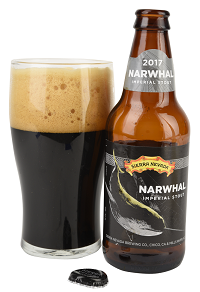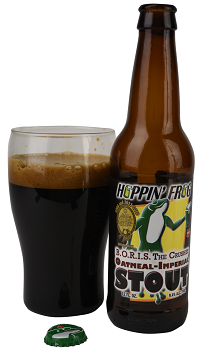Old Rasputin: North Coast’s Imperial Interpretation

(Photo by Jill McNamara)
By the time Catherine the Great, Empress of All Russia, started commissioning porter from London breweries in the 1780s, the ale had been a favorite import for decades. The fame of these strong, barrel-aged beers was already circling the globe, and versions of it were being made in Scotland, Ireland, and the newly-independent United States.
Those original London porters were made with a rough, smoky grain known as brown malt, and the beer, as it came out of the kettle, apparently wasn’t much fun to drink. Once brewers learned to let their porters sit in wooden vats for up to two years, though, a magical transformation happened; native microorganisms transformed an acrid beer into something refined and sherry-like.
Yet the word “imperial” that became associated with the porter bound for the Tsarina’s court—purportedly the strongest of the London porters—had a double meaning. That porter was made for imperial purposes, but porter itself had become beer’s monarch.
Eventually, of course, the great vat-aged porters gave way to other, lesser ales. The strongest versions—the “stout” porters—withered and grew tame. They were further diminished by the world wars, and by the 1950s, not a single brewery in England made a porter. Except for the success of its distant ancestor, Irish stout, the era of this style seemed over.
Three decades later, Mark Ruedrich and two cohorts were putting together the plans for a brewery in Fort Bragg, California. Ruedrich had been a homebrewer and had lived in England for two years, and long before starting North Coast Brewing, he’d become enchanted by stouts.
“I had also made my own special study of Guinness while living in England,” he says—and indeed Old No. 38, an Irish stout, was one of the beers North Coast offered when it debuted in 1988. But it was a different stout that would make North Coast famous, one he’d discovered as a homebrewer years before: Bert Grant’s Imperial Stout.
“It was a revelation for me,” he recalls. It was an evocation of those ancient Baltic-bound porters. “I thought that was a beer I’d very much like to brew one day.”
It took six more years before he began formulating Old Rasputin, and though it was inspired by Grant’s, he wanted it to be entirely original. Grant’s had been sweeter, maltier, and was only 6% ABV. “I thought, ‘I think we need to plant a stake in the ground.’ It was logical to give this beer a very American twist. Instead of doing a malty beer, doing something that was much more hop-forward.”
What emerged was nothing like the old vat-aged brown porters sent to Russia, and yet in its booming strength and intense flavors, Old Rasputin did capture their spirit. Ruedrich wanted it to express the character of American hopping, so he infused it with 75 international bitterness units of Centennial, Northern Brewer and Cluster hops. The Clusters are a nice touch—an old American hop, they were widely used in British brewing as a bittering hop in the 19th century. The hops give it a resinous, almost oily layer that augments the powerhouse roasted malts.
“One of the early lessons we learned in making Old 38 was that roasted barley is critical, and not using too much black malt is also critical,” says Ruedrich.
He created a foundation of caramel malts to add some balancing sweetness, and what he called “intermediate” malts for flavor. What’s an intermediate malt? Brown malt, for one—another wink to St. Petersburg.
As we were discussing the beer, Ruedrich called it “creamy but quite dry,” and that has always been my impression, too—right down to the words I’d used in tasting notes. Shortly after North Coast launched Old Rasputin, Goose Island began making a bourbon barrel-aged imperial stout, which now seems the default for American brewers. It has led the lineage of American stouts in a much sweeter direction than Ruedrich envisioned. The latest trend in “pastry stouts”—very sweet, confectionary ales—extends that tradition further. As a consequence, recent reviews have tended to ding Old Rasputin. “A bit light on body,” Craft Beer and Brewing observed. “Slightly astringent,” said Draft Magazine. “Too astringent, somewhat coarse,” one reviewer at Beer Connoisseur decided.
But these seem to take modern, gloopy, sweet imperials as the benchmarks, when Ruedrich was shooting for something entirely different.
“We use a low mash temperature to make an extremely fermentable wort to make sure this beer finishes as bone-dry as a [huge] beer can,” he says. And this is where Old Rasputin sings. The relative dryness reveals the layers of hopping and roast, so the palate shimmers with different flavors as it passes over the tongue—dark chocolate and cocoa, yeast esters that evoke cherry or red wine, that piney resin, a touch of char, and delicately sweet toffee, all wrapped up in that unusual creaminess. Most of the modern, sweeter imperials are built to be drunk in volumes of a few ounces. Old Rasputin, despite its intensity, sustains and nourishes the soul over the course of a full pint.
Porters and stouts have been many things over the past 300 years. At their most robust, they were beers that warmed the coldest Russian winter nights and inspired a world to start making them. Of all the modern interpretations, few match Old Rasputin’s ambition, daring, and accomplishment. It has earned the right to be called “imperial.”
Jeff Alworth is the author of The Secrets of Master Brewers and The Beer Bible.

Seventh Son Oubliette
ABV: 12% | Imperial StoutTasting Notes: Oubliette drizzles from the bottle like motor oil and rouses a dense brown head. These clues, along with the milk chocolate nose, hint at a beer with much residual sweetness. They don't mislead; Oubliette is intensely sweet, and finds a balance of intensities through massive loads of hop and malt bitterness.

Sierra Nevada Narwhal
ABV: 10.2% | Imperial StoutTasting Notes: Inky-black and dense, Narwhal is unusual for its subtle aromas, which only hint at cocoa. The flavor is unusual, too; there's an integrated roastiness, more a whole than a sum of parts, fused to rich, heady booziness. It washes over the palate in a wave, heading to a long, austere finish.

Hoppin’ Frog B.O.R.I.S. The Crusher
ABV: 9.4% | Oatmeal Imperial StoutTasting Notes: The blackness is so complete in Boris that it seems to stifle the head, though a perfume of chocolate and alcohol waft from the glass. A forcefully roasty stout, it has edges of char, Italian roast, and hop bitterness surrounding a blackberry center.

great story
great history with detail
great history
You can have all those strong sweet stouts. I’ll take Old Raspie any day of the week & in any month of the year! (And, I live in the one of the hottest cities in the U.S.!). Good stuff!
Storm King by Victory is still king of the Imperial stouts.
where can we find this beer?
https://northcoastbrewing.com/beers/beer-locator
Cheers!
Very interesting historical read. Thank you!
Would much rather have an Old Rasputin or Guinness Foreign Extra than these pastry stouts.